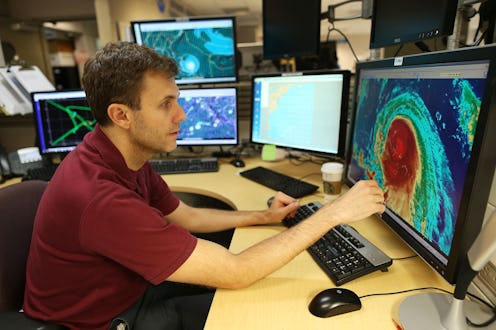
On Monday evening, Hurricane Maria first made landfall in the Caribbean, directly striking the small island of Dominica. The storm is exceedingly powerful: It hit Dominica as a Category 5 Hurricane, and is still classified as a Category 4 storm as it heads toward other parts of the Caribbean. Moreover, experts have also noted that Hurricane Maria has a pinhole eye, a perhaps unfamiliar term that means that the hurricane is exceptionally compact and powerful.
Hurricanes are essentially composed of three parts: the eye, the eyewall, and rainbands. A hurricane's eye constitutes the center of the storm, around which the entire storm rotates. On average, hurricane eyes are approximately 20 to 40 miles in diameter, though they can get as large as 50 miles for bigger storms. Interestingly, the eye is usually the calmest part of the storm and features clear skies, low pressure, and low level winds — at least over land. However, over sea, the eye can actually be the most devastating part of the storm, causing high and powerful waves.
A pinhole eye, like that of Hurricane Maria, occurs when the eye of the storm is much smaller than usual. In Maria's case, the storm's eye is approximately 10 miles in diameter. A smaller eye renders a hurricane more powerful, as it causes the storm around the eye to spin more quickly.
In addition to a hurricane's eye, its eyewall and its rainbands represent the other significant components of the storm. A hurricane's eyewall directly surrounds the eye and can be up to 30 miles wide. The eyewall contains the most powerful winds and rain in the storm system. Indeed, The Washington Post compared the intensity of a storm's eyewall to that of an "enormous tornado" that spins over locations for up to an hour.
Finally, rainbands are clouds, often thunderstorms, that move around the eyewall. Rainbands can be up to hundreds of miles long, depending on the size of the hurricane. The bands spin in a counter-clockwise fashion and also often contain very strong winds.
Unfortunately, Hurricane Maria has already demonstrated the powerful nature of a pinhole eye hurricane. Dominica, the island on which the storm first made landfall on Monday evening, is reportedly utterly devastated by the storm. The island's Prime Minister, Roosevelt Skerrit, published a Facebook post following the storm, describing the extent of the damage:
Initial reports are of widespread devastation. So far we have lost all what money can buy and replace ... I am honestly not preoccupied with physical damage at this time, because it is devastating … indeed, mind-boggling. My focus now is in rescuing the trapped and securing medical assistance for the injured.
Moreover, meteorologists are predicting that Maria could cause further widespread devastation as the storm moves through the Caribbean. It is expected to directly impact some of the Leeward Islands, including the U.S. Virgin Islands and the British Virgin Islands; Maria is also expected to strike Puerto Rico.
The most recent public advisory from the National Hurricane Center warns that Maria "remains an extremely dangerous hurricane after moving over Dominica." The advisory also warns that the islands in Maria's path can expect very strong winds, heavy rains, and very substantial sea level rise. Indeed, the advisory predicts an average of 12 to 18 inches of rain accumulation in Puerto Rico and 10 to 15 inches of accumulation in the U.S. and British Virgin Islands. This rainfall, coupled with rising sea levels, could result in severe and dangerous flooding.
Tragically, Hurricane Maria's pinhole eye serves as another indicator of strength of this storm — and the potential it has for causing widespread devastation. You can be sure that many people are thinking of those in Maria's path as the powerful storm makes its way through the Caribbean.